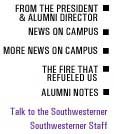The
Fire that Refueled Us
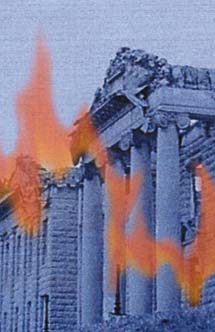 Half
a century has passed, but the memory still burns in the minds of those
who were in Winfield during the spring of 1950. It was April 16, 1950,
and Richardson Hall was on fire.
Half
a century has passed, but the memory still burns in the minds of those
who were in Winfield during the spring of 1950. It was April 16, 1950,
and Richardson Hall was on fire.
This majestic four-columned
structure, far more than simply an office or class building, was the
stones-and-mortar heart of Southwestern College. And as they watched
the accumulated memories of the college's first half century flamboyantly
crumbling to ash, those students, faculty, staff, and townspeople gathered
on the 77 steps must have had a single thought in their minds:
Could Southwestern
survive?
Although by far
the most spectacular, the Richardson fire was only one of three crises
during a 10-month span from September 1949 to June 1950. The first two
involved the unexpected and concurrent loss of the school's two principal
buildings, leaving it practically without classrooms or administrative
offices. This loss, in turn, gave rise to the third crisis, an attempt
to eliminate Southwestern by merging it out of existence.
But during the
next three years, the college's alumni, leadership, and friends rallied
under the strong leadership of an exceptional president, Alvin Murray.
The Richardson Fire, like the burning of prairie stubble, spurred the
college to renew itself as an institution that was stronger, more vital,
and more focused than ever.
It was the fire
that refueled us.
- Sara Weinert
Campus was quiet
as Saturday turned into Sunday April 16, 1950. A slight southeast breeze
was blowing, carrying an air of vitality and a sense of future direction
"far above the Walnut Valley." At 550, Southwestern's enrollment (although
down from the previous year) was quite high compared to the recent War
years. The school had grown steadily, adding faculty and courses, along
with new buildings.
Three stories below
Richardson's silver dome, though, a small custodian's closet in the
basement was about to become pivot point of the most important events
in the college's history. Cleaning materials in this closet, located
in a recess that today holds vending machines, had hours before begun
to heat up as the process leading to spontaneous combustion began. At
about midnight, the closet burst into flame.
The fire spread
rapidly down wooden corridors and through wooden doors and walls of
plaster. Soon it was on the first floor working its way up the rotunda
walls, toward the dome above.
Two college boys
discovered the fire and immediately reported it. Their efforts to douse
it were to no avail. The alarm was received at the Winfield firehouse
at 12:19 a.m. Firemen and equipment where soon on site. By then, however,
the fire had worked its way up and soon broke through the wooden structure
of the dome.
The rotunda and
the dome were transformed into a huge flue. It pulled the roaring flames
upward and through the building's insides in a matter of minutes, a
phenomenon predicted only a few days before during a fire inspection.
Firemen, now assisted by colleagues from Arkansas City and Wellington,
could do little but attempt to bring the fire under control and keep
it from spreading to other nearby structures. They focused their streams
of water on the vaults, located in the northeast corner, which held
the registrar's vital records.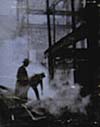
In the mild April
weather, a large crowd soon gathered about the base of the 77 steps,
watching in disbelief as the centerpiece of the Southwestern campus
was devoured by smoke and fire. Some would later remember the sickening
feeling they felt at the moment the dome came crashing down amid a shower
of sparks and flames; others noted the greenish-blue flames and pungent
odor given off by the Kibbe organ as it was consumed.
For onlookers,
the sense of disaster was heightened as the firelight revealed the exposed
rafters of North Hall, which, only six days before, workmen had started
to raze.
By 1:30 a.m., the
fire was at its height and could be seen for 25 to 30 miles about the
countryside. Firefighters finally subdued the fire around 5 a.m.-after
pouring approximately 300,000 gallons of water onto the conflagration-and
began packing up their equipment.
As dawn broke,
all that remained of Richardson Hall was its 16-inch-thick walls and
four massive columns. Its insides were a shell full of rubble and still-smoldering
ashes. Looking up toward the sky, one saw, wrapped around a beam, a
candelabra belonging to Helen Graham.
The fire spread
with such speed and intensity that there was no opportunity to rescue
Richardson's contents, except for a few odds-and-ends items pulled from
the flames. The action of firefighters in wetting down the vaults preserved
their irreplaceable contents of scholastic records, as well as documents
essential to doing business.
Still, the loss
was overwhelming. The building contained the accumulated treasures of
the college's 64 years of existence. Other than the vault files, the
college's records were destroyed. Then there was the memorabilia of
all sorts-pictures and paintings, trophies and banners, etc., all intended
to remind future students of past triumphs. Historic items went up in
smoke as well, such as famed evangelist Peter Cartwright's Bible, on
display in the rotunda.
The most pressing
loss was Richardson's many classrooms with their furnishings and equipment,
from 45 German microscopes secured after the Great War to the Kibbe
organ. Destruction was total in Miss Graham's drama department, with
its rich collections of props, costumes, scripts, and equipment, painstakingly
acquired over many years.
The only disciplines
escaping major loss were the food classes of home economics being held
at Newton Hospital; the music department, with its own building plus
facilities downtown; and athletics and the library, both located in
Stewart. With few exceptions, faculty members lost their class records,
along with personal items of varying value and importance. Few had insurance.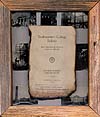
The impact of the
fire, devastating as it was, was felt even more sharply because of an
eerie coincidence in timing. Only days before, demolition of the campus's
other principal building had begun.
Early in September
1949, the state fire marshal had visited the campus. He found old North
Hall, the original college building opened in 1887, to be unsafe and
condemned it. Fortunately, the building did not have to be vacated immediately
and continued in use until Christmas break. At that time, the science
and art departments moved into refurbished quarters in Richardson Hall.
The work of razing
of North Hall began on April 10, 1950. The loss of the building, with
its numerous classrooms and labs, was a crisis-coming as it did without
warning and at the beginning of the school year-but a manageable one,
given that almost four months existed to relocate.
And the impact
of the loss was lessened by the existence of plans for a new facility.
As far back as 1945, the trustees had approved a plan to convert North
Hall into a new science facility. Fund raising had gathered $65,000
toward the project, when the Central Kansas Conference (the Methodist
organization that had founded Southwestern) halted it. With condemnation,
however, the Conference approved a new campaign to raise an additional
$115,000 to be added to the original amount. A new science hall was
to be erected and named in honor of President Frank E. Mossman. The
renewed campaign for funds was underway as 1950 began.
But as April 16,
1950, dawned, nearly the entire academic facilities at Southwestern
College had been reduced to rubble and ashes.
Richardson Hall
and its contents were insured. The college collected $298,000-but mere
dollars could never replace what had been lost. Since its erection in
1909, the building had become the symbol of the college and a familiar
landmark. With the passing of Richardson Hall and North Hall passed
the old order: The school put in place by Frank E. Mossman and Albert
E. Kirk and romanticized by Dean Leroy Allen, Margaret Hill McCarter,
and others, was no more.
Sunday afternoon,
with the fire still smoldering, President Alvin W. Murray and his staff
met to lay plans for carrying on the immediate work of the school for
the 35 days remaining until graduation and to begin its reconstruction.
Murray had been
president for only six months, and was facing one of the worst moments
of the college's history. At this point his strong management and leadership
style came into play. It was decided that classes at Southwestern would
continue and resume on Tuesday, April 18. Later, it would become a boast
of the school that only one-half day of classes was lost due to the
fire.
The only classrooms
that remained on campus were in the Music Hall. It was decided to make
use of them and all other suitable rooms on campus, plus space in Grace
Methodist Church and private homes. After the meeting, President Murray
met with the press. His tone was positive and forward-looking. He made
three points: 1) The school would be rebuilt bigger and better than
ever; 2) no student records had been lost; and 3) school would resume
on Tuesday morning; there would be no major change in the academic schedule,
including plans for summer school.
Early Tuesday morning,
an all school assembly was held in Stewart Field House. President Murray
reassured the students, telling them of plans to rebuild, centering
on a new science hall with the latest equipment, a new library, and
the reconstruction of Richardson Hall.
" know now it was
not a midnight experience, but rather the dawn of a new day," he told
the students. Students were given their classroom assignments. Classes
resumed.
Murray immediately
sought out support from all sources. His objectives were to secure funds
for rebuilding and approval of the rebuilding program from the Central
Kansas Conference. Alumni and friends were contacted. In coming days,
donations, big and small, would flow in from around the country. On
April 25, President Murray spoke to the Conference's education board,
which gave him and the school a reassuring vote of support. A check
for $10,000 was also received from the Methodist General Board of Education
in Nashville.
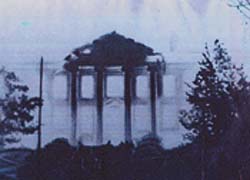 By
far the most important outpouring of support for Southwestern came from
Winfield. Four days after the fire the Winfield Chamber of Commerce
authorized a campaign to raise $300,000 for rebuilding Southwestern.
This effort, headed by Hobart L. Barbour, proved crucial to the survival
of the school, not only in providing essential funds but also in demonstrating
concretely the importance of the school to the city and its affection
for the college.
By
far the most important outpouring of support for Southwestern came from
Winfield. Four days after the fire the Winfield Chamber of Commerce
authorized a campaign to raise $300,000 for rebuilding Southwestern.
This effort, headed by Hobart L. Barbour, proved crucial to the survival
of the school, not only in providing essential funds but also in demonstrating
concretely the importance of the school to the city and its affection
for the college.
In one respect,
Southwestern was blessed: Development and expansion plans had been under
consideration since 1944, when former President Charles E. Schofield
had presented such a plan to the Conference. General plans not only
existed for a new science hall and library facility-but cash and pledges
were in hand towards their construction, raised by the college and citizens
of Cowley County. President Murray directed the architect to hurry his
plans to completion.
As for the new
administration building, a decision was made to rebuild using Richardson's
walls. When completed, the plans did not include a rotunda. This was
to be expected after the role it played in the fire, but totally unexpected
was the absence of the familiar silver dome. It was eliminated because
it would have added $30,000 to the cost.
Dr. Murray packaged
the construction plans into the Million Dollar Building Program, which
was to receive considerable publicity. Already $805,000 had been or
was being raised, leaving a need for additional $195,000. In the meantime,
school had continued, and students were meeting the situation with loyalty
and cooperation.
Finally came May
and Commencement week. Dr. Murray and the trustees had in place a realistic,
achievable plan for funding and building a new campus. It would do much
to restore confidence in Southwestern's future.
The graduating
class numbered 130; there had been only three larger classes.
The college's most
critical moment was still to come, though: A special session of the
Central Kansas Conference was called to confirm actions taken and to
approve the development program.
Since 1939, a cloud
had hung over Southwestern. In that year, the old Southwest Conference,
which had established Southwestern in 1885, had merged with the Northwest
Conference to create the Central Kansas Conference. The new conference
found itself with two colleges, Southwestern and Kansas Wesleyan. Doubts
were soon expressed that the Conference should support two institutions
of higher learning. Would it not be wiser to combine the two, making
for a more financially secure and higher quality institution?
In 1944, the National
Board of Education of the Methodist Church surveyed the situation and
concluded that one would be better than two. Questions were raised about
the adequacy of the report, and the Central Kansas Conference voted
to continue with two institutions-but no definitive decision was made.
The loss of North Hall and Richardson forced the issue, since Southwestern
could not go forward with its funding and building program without the
Conference's blessing. Dr. Murray called on all Builders and friends
of the school to rally to its support. Failure to obtain Conference
approval, he warned, "would deal a crushing blow to Southwestern."
The Special Session
of the Central Kansas Conference met Thursday, June 29, 1950, at Hutchinson.
As members gathered, they were troubled not only by the immediate question
before them, but also by events half a world away. On Sunday, June 25,
the morning headlines had brought accounts of the North Korean invasion
of the South. President Truman, vacationing in Independence, Mo., had
returned to the Capital. The situation worsened steadily throughout
the week. There was talk of U.S. involvement. The delegates were aware
of what war would mean for Southwestern, especially for male enrollment.
On June 26, President
Murray addressed the Winfield Chamber of Commerce, stating bluntly:
"The future of Southwestern College to a large extent will be determined
at the Methodist Conference.." On Tuesday, June 27, the Chamber's Southwestern
College Development Fund Drive officially began with a big kick-off.
On June 29, as the contending forces gathered at Hutchinson, the Courier
carried an architect's rendering of what the Southwestern campus would
look like after rebuilding.
Murray had as his
objective at Hutchinson the immediate approval of the Million Dollar
Building Program-no delays for further study, as some would propose-so
that all concerned with Southwestern's fate would know its future.
To his surprise,
President Murray had to fend off a renewed drive to merge Southwestern
and Kansas Wesleyan. Forces from Hutchinson, where he had previously
served as pastor, pushed the idea, anticipating that the new college
would be located in their home community. In a dramatic presentation,
Murray, assisted by Raymond Dewey, confronted the proponents of merger.
Murray, an outstanding speaker and debater, spoke for 40 minutes on
the development program and current status of the college. Dewey followed
with a most effective speech attacking the merger concept. Murray concluded
with final arguments.
The vote was taken
and the motion to merge was defeated handily, 241 to 98. The motion
for the Million Dollar Building Program was then approved by a substantial
vote of 267 to 54. The "On Southwestern!" forces were triumphant.
The future of Southwestern
College was settled, the cloud lifted!
As the galleries
broke out in cheers, Lester Hankins of Wellington declared the historic
session "Alvin Murray Day." The following day Southwestern and Winfield
celebrated, while in Washington, President Truman ordered U.S. ground
troops to the aid of South Korea. The Korean Conflict had begun.
After the victory,
Dr. Murray moved aggressively to raise funds and carry out the building
program.
In September 1953-three
years and four months after the fire-all the new buildings were in place
and in use. More funds and work, however, would be required to complete
the structures in all aspects, as well as to furnish and equip them
fully. For instance, the administration building's first floor remained
unfinished with a floor of dirt and its auditorium lacked air-conditioning.
Moreover, a clear need also existed for additional dormitory and classroom
facilities.
These challenges,
however, would have to await Dr. Murray's successor.
In late June 1953,
Alvin W. Murray resigned, effective July 1. There had been disagreements
with certain trustees. Dr. Murray had been an effective leader-demonstrating
his Builder spirit-at a crucial moment in Southwestern's history. He
could look back with satisfaction on having saved his alma mater and
overseen its rebirth. While challenges remained, he left Southwestern
positioned for a future of significant growth and development.
Many individuals
and groups played crucial roles in helping Southwestern survive its
three crises. Perhaps the most remarkable aspect of this story is Southwestern's
many, many friends who rallied to its support in its hour of need. The
college's 64 years of service to the Methodists of Kansas and its home
community of Winfield were remembered and well repaid.
The college owes
its existence to many: Those students, enduring hardship and inconvenience
without complaint.the alumni, who gave their alma mater their full and
faithful support.the faculty, with professionalism and dedication to
their students.the Board of Trustees, providing crucial vision and support
during this period.the citizens of Winfield, who were determined to
save Southwestern.and those members of the Central Kansas Conference
who recognized South-western's value to Christian education in Kansas
and, when the question was put, chose to preserve it for the future.
